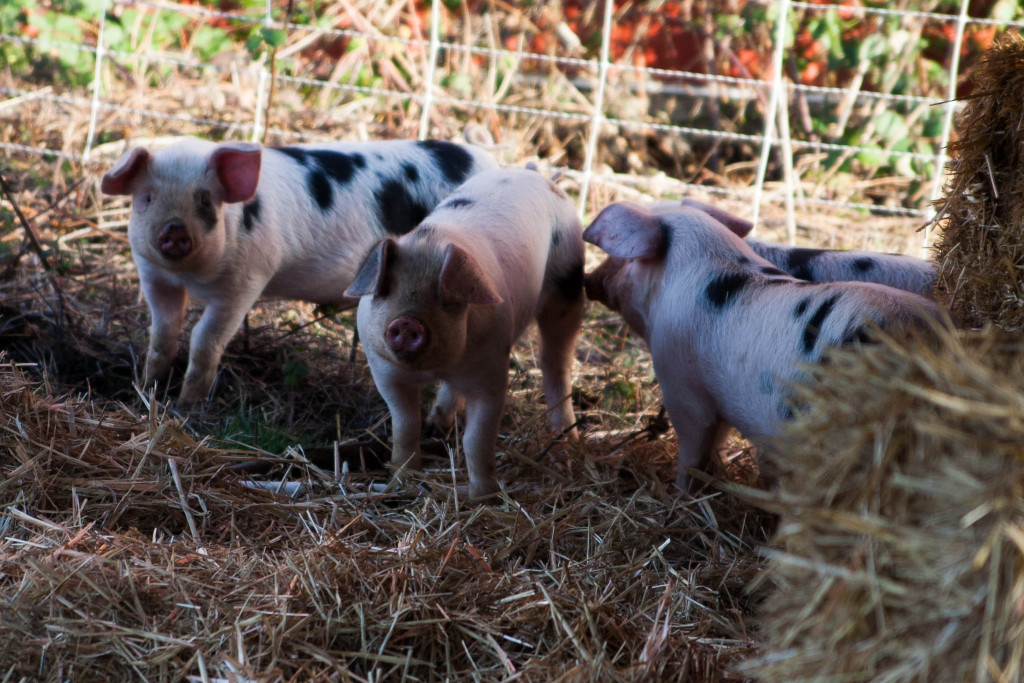
How our decision to raise and slaughter animals reconnected us to the land and to the language of Scripture.
One of my neighbors came up to me a while back as an unofficial delegate for the rest of the neighborhood. They were concerned about us getting pigs.
“I can’t tell you what you can do with your land, of course,” he said, but judging from his grave tone, it was clear that the neighborhood was unanimous in their disapproval of our pig-raising plans.
Over the months that followed, I kept hearing whispers of lingering frustration. Are they still intent on getting pigs? Nobody talked to me directly. If they had I would have explained how our approach to livestock and land management was different. We would not be creating a muddy cesspool of pig feces and slop that would stink up the entire neighborhood. We would be raising our porcine friends on pasture in a small-scale rotational system that would keep them moving to fresh vegetation throughout their lives. There would be almost no smell, and over the next few years it would actually work to regenerate the soil and the diversity of the pasture grasses through the natural rooting, grazing (yes, pigs will graze) and pooping of these wonderful creatures.
Once we got our pigs, I made a point of inviting all our neighbors over to meet them, especially the neighbors that were a bit more leery. The one that had been most concerned later told me that she just didn’t know it was even possible to raise pigs the way we were raising them. Her only exposure to pigs came through a childhood visit to a pig farm, where they’d kept the animals in confinement, in a sort of hellish underworld of creaturely misery.
By nature, pigs are smart, clean, social, and unbelievably hard-working. Depending on which study you trust, they are either the 2nd or 4th smartest animals on the planet. But when you take them out of a natural environment, and put concrete under their feet, and force them to live in their own feces, they become irritable, prone to disease, and they smell like death. You would, too!
Most of us are steeped in the language that modern industrial agriculture has made the norm. We hear “pigs,” and we think, “gross.” And it isn’t only our view of pigs that have been shaped by the modern farming industry. Images of feedlots filled with sad cows and tractors making long straight rows of a single crop across an endless open landscape fill our imaginations. Farming the land has become the dull work of sitting in an air-conditioned cab while a combine directs itself across a thousand acres via GPS.
More than meat
My wife, Allison, and I didn’t grow up farming. We spent most of our adult lives in Portland, disconnected from the patterns and rhythms of the natural world. Our journey toward producing rather than merely consuming has been a slow but steady process that started with making our bread from scratch.
During the transition we have felt our detachment from the natural world in many different ways. We’ve seen it in the steep learning curve we’ve faced as we grow vegetables, graft and plant trees, enrich soil, raise chickens, ducks, geese, and pigs. But there is one aspect of our new life that was particularly challenging: the slaughter of animals.
When we got our pigs, we knew we were raising them for meat. We knew what that meant, but we were not quite ready for the reality of it.
As a child—no lie—I didn’t realize that the chicken we bought in the store came from a living, breathing, chicken. I guess I must have known on some level, but it was buried deep enough in the recesses of my brain that I never looked askance at my dinner plate.
My first exposure to the slaughter of an animal was just over a year ago. Our farm had been running for a few years, but we raised chickens only for eggs and hadn’t yet processed an animal. I knew it wouldn’t be long before I would have to be intimately involved in the death of one our precious stock. At that point we had pigs that were going to be slaughtered in a few months time, we needed to harvest a few of our male ducks, and we were about to raise geese to eat and sell for Christmas dinners.
To help me prepare for what was coming, we attended a fair in Albany, Oregon, where we watched a chicken processing demonstration done by Joel Salatin. Salatin may be America’s most famous farmer and I deeply respect him. The demonstration was for people like me, on the cusp of harvesting our own animals, but not quite there yet.
Before the demonstration began, Joel, a Christian, talked about how he felt a little conflicted whenever he did these demonstrations. The reason? They always fall on a Sunday, he explained and he didn’t like to miss church. So he decided to turn our gathering of about 300 people into a church service. Under that tent in the blistering sun of the hottest Pacific Northwest summer on record, were urban farmers of the Portland hipster variety, old guard hippies doused in patchouli oil, ranchers from the expansive grasslands of southern Oregon, and just about every other kind of farm and homestead enthusiast you can imagine.
Joel preached a simple sermon of only two lines: “Let’s take a moment to reflect on the process of life, death, decomposition, and regeneration. The sacrifice of an animal is a sacred act because they are making a sacrifice so that we can live.”
Joel proceeded to thank the animals as he killed them, using the traditional halal and kosher method of slaughter. As I watched I thought it’s hard to think of anything that demonstrates the message of the gospel more clearly than the sacrifice of an animal to provide life-giving food.
Flesh become words
Putting the slaughter of animals in the hands of a few massive industrial meat-processing facilities has disconnected our culture from the slaughter of animals. We’ve seen this firsthand. Many of our customers refuse to come to our farm because they don’t want to meet the pig they are buying from us. I believe industrial farming has, in this way, diminished the weight of our spiritual language and facilitated the exploitation of animals along the way.
The language of slaughter and sacrifice is everywhere in the Scriptures, especially in the Hebrew Bible. Yet being disconnected from the process of slaughter, we fail to experience its reality in any visceral sense. I wonder how this has affected our capacity to understand the nature of Christ’s sacrifice?
The day our pigs were slaughtered, I stood soberly by as the mobile butcher quickly and humanely put our animals down out in their pasture. I watched as they were skinned and cleaned and prepared to go to the butcher, who would cut the bodies of our animals it into smaller parts to be rationed throughout our year.
Since becoming more connected to this process, we eat our meat with more reverence. We try to purchase all of our meat direct from farmers that we know, and will even visit on the day of slaughter so that we can collect vital organs that would otherwise be thrown away.
We’re realizing the need to become reconnected to the land and to God’s creatures, to steward the goods of the created world. We tend to think that people in Bible times lived in an agrarian society, but that we are not in one now. All societies are agrarian. Without agriculture there is no food. The question is not if we are agrarian, but what sort of agrarian society we are. I believe we must become the sort of agrarian society that is committed to regenerative farming, that stewards the land, and reconnects communities to the source of their food.
The future fertility of our land and the security of our food system depend on it. But so does our spiritual growth and vitality. Scripture is crammed with imagery drawn from the world God made. Images of slaughter and sacrifice, planting and watering, seasons and harvest. That language has been diminished by our current relationship to the land. We don’t need new metaphors; we need to reconnect to the language we’ve been given.
Not everybody will become a farmer. Not everybody should. But within the community of faith I believe reconnecting to the land, our food, to the wild places and the cultivated landscapes, is necessary if we are to enrich our faith in Christ and preach him effectively to a fallen world.
Transitioning to this sort of stewardship is deeply rewarding and attractive. Our neighbors are no longer concerned that we raise pigs. They are beginning to understand that the pigs are actually helping increase the fertility of our little piece of land and provide food to others. I like to think that they also see us trying, really trying, to work with the land, improve it, and make it more beautiful and inviting. We want our little farm to preach to others, even as it continues to proclaim the life—and death—of Jesus to us.

